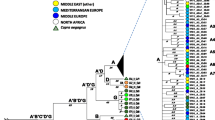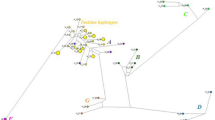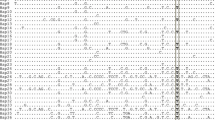Abstract
For the first time, the analysis of polymorphism of complete mitochondrial genomes was performed in three Dagestan local goat populations (n = 37), which were characterized by high genetic and haplotype diversity. We found that 90.88% of the total genetic variability was due to intragroup differences and 4.86% was due to intergroup differences. For the studied sample of goats, significant negative values of the Tajima’s D and Fu’s Fs neutrality indices were calculated (P < 0.05). We performed a phylogenetic analysis using the nucleotide sequences of domestic goats and bezoars belonging to different haplogroups. Our study revealed that all studied samples of Dagestan Local goats belonged to haplogroup A, which is the most frequent one in domestic goats.



Similar content being viewed by others
REFERENCES
Novopashina, S.I., Sannikov, M.Yu., Khatataev, S.A., et al., Sostoyaniye i perspektivnyye napravleniya uluchsheniya geneticheskogo potentsiala melkogo rogatogo skota: nauch. analit. obzor (State of the Art and Promising Directions of Improving the Genetic Potential of Small Cattle: Research and Analytical Review), Moscow: Rosinformagrotekh, 2019.
Khaiitov, A.Kh., Stanishevskaya, O.N., and Safarov, T.S., Biological and economically important traits of local goats, Izv. S.-Peterb. Gos. Agrar. Univ., 2016, no. 45, pp. 139—145.
Musalaev, Kh.Kh., State of the art and the development prospects of goat breeding in Dagestan, Gorn. Sel’sk. Khoz., 2015, no. 1, pp. 118—123.
Lebel’, L.D. and Zelenskii, Yu.G., Kozovodstvo i kozy Dagestana (Goat Breeding and Goats of Dagestan), Pyatigorsk: Sevkavvedizdat, 1936.
Kumar, A., Rout, P.K., Mandal, A., and Roy, R., Identification of the CSN1S1 allele in Indian goats by the PCR-RFLP method, Animal, 2007, vol. 1, no. 8, pp. 1099—1104. https://doi.org/10.1017/S1751731107000444
Li, M.J., Zhang, C.M., Lan, X.Y., et al., Analysis of POU1F1 gene DdeI polymorphism in Chinese goats, Genet. Mol. Res., 2016, vol. 15, no. 1, p. 15017747. https://doi.org/10.4238/gmr.15017747
Naderi, S., Rezaei, H.-R., Taberlet, P., et al., Large-scale mitochondrial DNA analysis of the domestic goat reveals six haplogroups with high diversity, PLoS One, 2007, no. 2. e1012. https://doi.org/10.1371/journal.pone.0001012
Zhao, Y., Zhao, R., Zhao, Z., et al., Genetic diversity and molecular phylogeography of Chinese domestic goats by large-scale mitochondrial DNA analysis, Mol. Biol. Rep., 2014, vol. 41, no. 6, pp. 3695—3704. https://doi.org/10.1007/s11033-014-3234-2
Colli, L., Lancioni, H., Cardinali, I., et al., Whole mitochondrial genomes unveil the impact of domestication on goat matrilineal variability, BMC Genomics, 2015, no. 16, p. 1115. https://doi.org/10.1186/s12864-015-2342-2
Tarekegn, G.M., Tesfaye, K., Mwai, O.A., et al., Mitochondrial DNA variation reveals maternal origins and demographic dynamics of Ethiopian indigenous goats, Ecol. Evol., 2018, vol. 8, no. 3, pp. 1543—1553. https://doi.org/10.1002/ece3.3710
Diwedi, J., Singh, A.W., Ahlawat, S., et al., Comprehensive analysis of mitochondrial DNA based genetic diversity in Indian goats, Gene, 2020, no. 756, p. 144910. https://doi.org/10.1016/j.gene.2020.144910
Voronkova, V.N., Piskunov, A.K., Nikolaeva, E.A., et al., Haplotype diversity of Mongolian and Tuvan goat breeds (Capra hircus) based on mtDNA and Y‑chromosome polymorphism, Russ. J. Genet., 2021, vol. 57, no. 10, pp. 1170–1178. https://doi.org/10.1134/S102279542110015X
Wang, G.Z., Chen, S.S., Chao, T.L., et al., Analysis of genetic diversity of Chinese dairy goats via microsatellite markers, J. Anim. Sci., 2017, vol. 95, no. 5, pp. 2304—2313. https://doi.org/10.2527/jas.2016.1029
Menezes, M., Martinez, A.M., Filho, E., et al., Diversity analysis and genetic relationships among local Brazilian goat breeds using SSR markers, Animals, 2020, vol. 10, no. 10, p. 1842. https://doi.org/10.3390/ani10101842
Selionova, M.I., Aibazov, M.M., Mamontova, T.V., et al., 42 Genetic differentiation of Russian goats and wild relatives based on microsatellite loci, J. Anim. Sci., 2020, vol. 98, suppl. 4, pp. 19—20. https://doi.org/10.1093/jas/skaa278.037
Beketov, S.V., Piskunov, A.K., Voronkova, V.N., et al., Genetic diversity and phylogeny of fleece-bearing goats of Central and Middle Asia, Russ. J. Genet., 2021, vol. 57, no. 7, pp. 816—824. https://doi.org/10.1134/S1022795421070036
Brito, L.F., Kijas, J.W., Ventura, R.V., et al., Genetic diversity and signatures of selection in various goat breeds revealed by genome-wide SNP markers, BMC Genomics, 2017, vol. 18, no. 1, p. 229. https://doi.org/10.1186/s12864-017-3610-0
Burren, A., Neuditschko, M., Signer-Hasler, H., et al., Genetic diversity analyses reveal first insights into breed-specific selection signatures within Swiss goat breeds, Anim. Genet., 2016, vol. 47, no. 6, pp. 727—739. https://doi.org/10.1111/age.12476
Colli, L., Milanesi, M., Talenti, A., et al., Genome-wide SNP profiling of worldwide goat populations reveals strong partitioning of diversity and highlights post-domestication migration routes, Genet. Sel. Evol., 2018, vol. 50, no. 1, p. 58. https://doi.org/10.1186/s12711-018-0422-x
Deniskova, T.E., Dotsev, A.V., Selionova, M.I., et al., SNP-based genotyping provides insight into the West Asian origin of Russian local goats, Front. Genet., 2021, no. 12, p. 708740. https://doi.org/10.3389/fgene.2021.708740
Piras, D., Doro, M.G., Casu, G., et al., Haplotype affinities resolve a major component of goat (Capra hircus) mtDNA D-loop diversity and reveal specific features of the Sardinian stock, PLoS One, 2012, vol. 7, no. 2. e30785. https://doi.org/10.1371/journal.pone.0030785
Tabata, R., Kawaguchi, F., Sasazaki, S., et al., The Eurasian steppe is an important goat propagation route: a phylogeographic analysis using mitochondrial DNA and Y-chromosome sequences of Kazakhstani goats, Anim. Sci. J., 2019, vol. 90, no. 3, pp. 317—322. https://doi.org/10.1111/asj.13144
Fernández, H., Hughes, S., Vigne, J.-D., et al., Divergent mtDNA lineages of goats in an Early Neolithic site, far from the initial domestication areas, Proc. Natl. Acad. Sci. U.S.A., 2006, vol. 103, no. 42, pp. 15375—15379. https://doi.org/10.1073/pnas.0602753103
Langmead, B. and Salzberg, S., Fast gapped-read alignment with Bowtie 2, Nat. Methods, 2012, no. 9, pp. 357—359. https://doi.org/10.1038/nmeth.1923
Danecek, P., Bonfield, J.K., Liddle, J., et al., Twelve years of SAMtools and BCFtools, Giga Sci., 2021, vol. 10, no. 2. giab008. https://doi.org/10.1093/gigascience/giab008
Hassanin, A., Bonillo, C., Nguyen, B.X., and Cruaud, C., Comparisons between mitochondrial genomes of domestic goat (Capra hircus) reveal the presence of numts and multiple sequencing errors, Mitochondrial DNA, 2010, vol. 21, nos. 3—4, pp. 68—76. https://doi.org/10.3109/19401736.2010.490583
Bernt, M., Donath, A., Jühling, F., et al., MITOS: improved de novo metazoan mitochondrial genome annotation, Mol. Phylogenet. Evol., 2013, vol. 69, no. 2, pp. 313—319. https://doi.org/10.1016/j.ympev.2012.08.023
Edgar, R.C., MUSCLE: multiple sequence alignment with high accuracy and high throughput, Nucleic Acids Res., 2004, vol. 32, no. 5, pp. 1792—1797. https://doi.org/10.1093/nar/gkh340
Kumar, S., Stecher, G., and Tamura, K., MEGA7: Molecular Evolutionary Genetics Analysis version 7.0 for bigger datasets, Mol. Biol. Evol., 2016, vol. 33, no. 7, pp. 1870—1874. https://doi.org/10.1093/molbev/msw054
Tajima, F., Statistical method for testing the neutral mutation hypothesis by DNA polymorphism, Genetics, 1989, vol. 123, pp. 585—595. https://doi.org/10.1093/genetics/123.3.585
Fu, Y.-X., Statistical tests of neutrality of mutations against population growth, hitchhiking and background selection, Genetics, 1997, vol. 147, pp. 915—925. https://doi.org/10.1093/genetics/147.2.915
Rozas, J., Ferrer-Mata, A., Sánchez-DelBarrio, J.C., et al., DnaSP 6: DNA sequence polymorphism analysis of large data sets, Mol. Biol. Evol., 2017, vol. 34, no. 12, pp. 3299—3302. https://doi.org/10.1093/molbev/msx248
Excoffier, L. and Lischer, H.E.L., Arlequin Suite ver. 3.5: a new series of programs to perform population genetics analyses under Linux and Windows, Mol. Ecol. Resour., 2010, vol. 10, pp. 564—567. https://doi.org/10.1111/j.1755-0998.2010.02847.x
Lanfear, R., Frandsen, P.B., Wright, A.M., et al., PartitionFinder 2: new methods for selecting partitioned models of evolution for molecular and morphological phylogenetic analyses, Mol. Biol. Evol., 2017, vol. 34, no. 3, pp. 772—773. https://doi.org/10.1093/molbev/msw260
Akaike, H., A new look at the statistical model identification, IEEE Trans Auto Control, 1974, no. 19, pp. 716—723. https://doi.org/10.1109/TAC.1974.1100705
Bandelt, H.J., Forster, P., and Röhl, A., Median-joining networks for inferring intraspecific phylogenies, Mol. Biol. Evol., 1999, vol. 16, pp. 37—48. https://doi.org/10.1093/oxfordjournals.molbev.a026036
Leigh, J.W. and Bryant, D., Popart: full-feature software for haplotype network construction, Methods Ecol. Evol., 2015, vol. 6, no. 9, pp. 1110—1116. https://doi.org/10.1111/2041-210X.12410
Ronquist, F., Teslenko, M., van der Mark, P., et al., MrBayes 3.2: efficient Bayesian phylogenetic inference and model choice across a large model space, Syst. Biol., 2012, vol. 61, no. 3, pp. 539—542. https://doi.org/10.1093/sysbio/sys029
http://tree.bio.ed.ac.uk/software/figtree/.
Hassanin, A., Ropiquet, A., Couloux, A., and Cruaud, C., Evolution of the mitochondrial genome in mammals living at high altitude: new insights from a study of the tribe Caprini (Bovidae, Antilopinae), J. Mol. Evol., 2009, vol. 68, no. 4, pp. 293—310. https://doi.org/10.1007/s00239-009-9208-7
Md Naim, D., Kamal, N., and Mahboob, S., Population structure and genetic diversity of Aedes aegypti and Aedes albopictus in Penang as revealed by mitochondrial DNA cytochrome oxidase I, Saudi J. Biol. Sci., 2020, vol. 27, no. 3, pp. 953—967. https://doi.org/10.1016/j.sjbs.2020.01.021
Deniskova, T., Bakoev, N., Dotsev, A., et al., Maternal origins and haplotype diversity of seven Russian goat populations based on the D-loop sequence variability, Animals, 2020, vol. 10, no. 9, p. 1603. https://doi.org/10.3390/ani10091603
Funding
The work was financially supported by the Ministry of Science and Higher Education of the Russian Federation, grant no. 075-15-2021-1037 (internal no. 15.BRC.21.0001).
Author information
Authors and Affiliations
Corresponding authors
Ethics declarations
Conflict of interest. The authors declare that they have no conflict of interest.
Statement on the welfare of animals. The authors declare that they have no conflict of interest. All applicable international, national, and/or institutional guidelines for animal care and use have been followed.
Rights and permissions
About this article
Cite this article
Deniskova, T.E., Dotsev, A.V., Selionova, M.I. et al. Characteristics of Dagestan Local Goat Subpopulations (Capra hircus) Based on the Analysis of the Complete Mitogenome Polymorphism. Russ J Genet 58, 988–996 (2022). https://doi.org/10.1134/S1022795422050040
Received:
Revised:
Accepted:
Published:
Issue Date:
DOI: https://doi.org/10.1134/S1022795422050040




